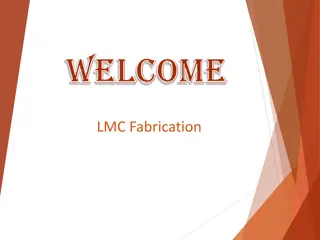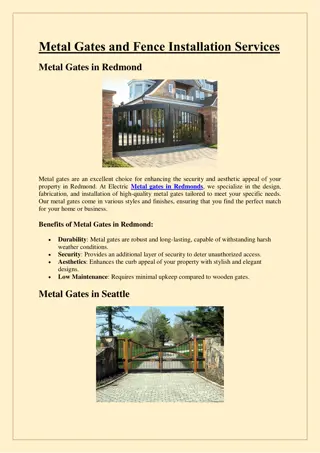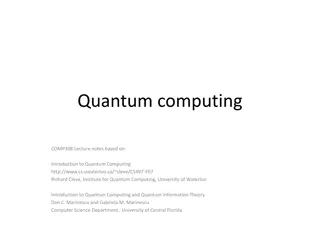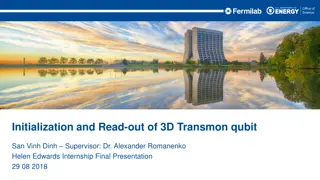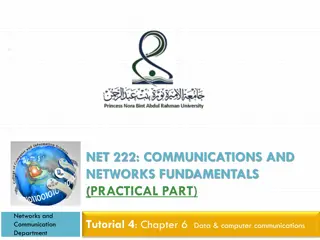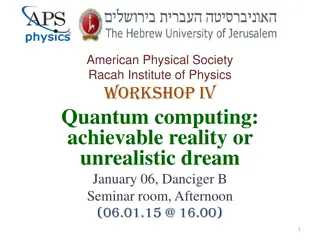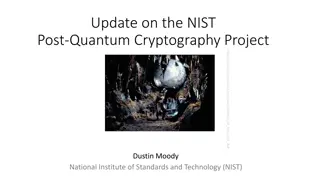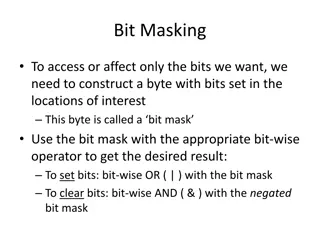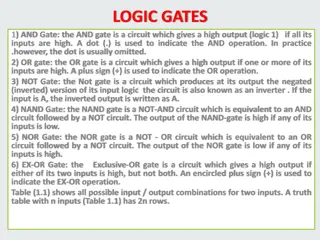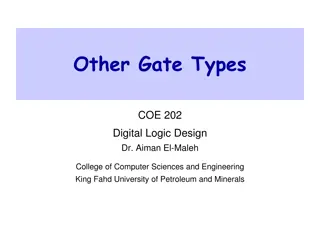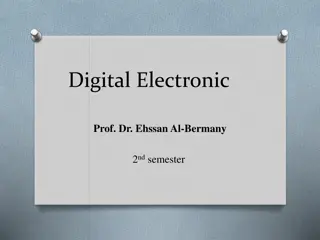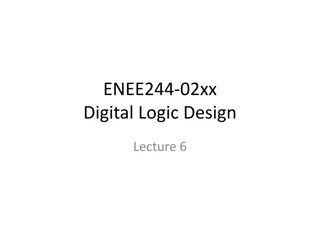Understanding Quantum Computing: Quantum Gates, Bits, and Applications
Explore the world of quantum computing with this detailed guide covering quantum bits, gates, their applications, and the advancements made in the field. From classical bits to qubits, Bell states, and quantum gates, discover the fundamental principles that drive quantum computing forward.
Download Presentation

Please find below an Image/Link to download the presentation.
The content on the website is provided AS IS for your information and personal use only. It may not be sold, licensed, or shared on other websites without obtaining consent from the author. Download presentation by click this link. If you encounter any issues during the download, it is possible that the publisher has removed the file from their server.
E N D
Presentation Transcript
QUANTUM GATES Lucas Nunes
CONTENT Introduction Quantum bits Quantum gates Applications Conclusion
INTRODUCTION Paul Benioff (1980)
INTRODUCTION Paul Benioff (1980) Richard Feynman and Yuri Manin (1986)
INTRODUCTION Paul Benioff (1980) Richard Feynman and Yuri Manin (1986) Quantum supremacy, Google (2019)
QUANTUM BITS Classical bits: can assume values 0 or 1. Quantum analogous: quantum bits or qubits for short. It also has two possible states | 0 or | 1 . It can be in a linear combination of the states.
QUANTUM BITS The information about qubits are limited. We can write, the state of a qubit as We can represent the states in as vectors:
QUANTUM BITS The information about qubits are limited. We can represent the states in as vectors:
QUANTUM BITS To perform useful computation it is necessary at least two qubits. We can prepare a Bell state (or EPR pair). The state is written as
QUANTUM BITS The Bell state: Or 1 with 50% probability leading to state The measurement outcomes are correlated. If the first spin is measured two results are possible: 0 with 50% probability leading to state
QUANTUM BITS The Bell state:
QUANTUM GATES In classical computing the information (carried by bits) can be stored in HD s or transformed by logic gates.
QUANTUM GATES We can look to a quantum analogous of the NOT gate, which acts linearly,so We can represent the NOT gate in matrix form
QUANTUM GATES If we apply this gate one more time we return to the initial state ?? = ?. There is a gate without a classical analogous, is the Hadamard gate It creates the superposition of states:
QUANTUM GATES Another important gate is the phase gate, associated to the Z operator (??) . It applies a phase ? over the state |1 , so that 0 |0 and 1 |1 .
QUANTUM GATES There are infinite gates for one qubit They must be reversible, i.e, ? ? = ? Note that X,Z and ? are unitary operators.
QUANTUM GATES Any logic gate of one qubit can be represented using a combination of rotations as This is representes the rotation of the Bloch vector by an angle ? around a ? axis.
QUANTUM GATES The Z gate can be represented by a rotation about the ? axis of 180 . The X gate is a rotation about the ? axis of 180 (or a ? pulse). The H gate is a rotation about the ? axis of 90 (or a ?/2 pulse).
QUANTUM GATES The mult-qubit quantum logic gate is the controlled-NOT or CNOT. It has two qubits input: target and control. In matrix format
QUANTUM GATES If ? is a logic gate which acts on ? qubits. One can define the controlled-U gate.
QUANTUM GATES Other two important controlled gates are the controlled phase gate and the SWAP gate. The CtrlZ gate adds a ? phase only to |11 state. The Swap gate exchange the state of two qubits.
APPLICATIONS Bell state
APPLICATIONS Scattering circuit By measuring the expectation values ?? and ?? one can obtaing information about the interaction ? or the input state ?.
APPLICATIONS Scattering circuit
APPLICATIONS Scattering circuit
APPLICATIONS Scattering circuit
APPLICATIONS Quantum teleportation |?
APPLICATIONS Quantum teleportation She interacts the qubit unknow with her half of Bell state The result will be: 00, 01, 10 or 11. She sends this information to Andre. Depeding on Thalyta s message, Andre performs one of four operations on his half of Bell state.
APPLICATIONS Quantum teleportation
APPLICATIONS Quantum teleportation
APPLICATIONS Quantum teleportation
APPLICATIONS Quantum teleportation
APPLICATIONS Quantum teleportation
APPLICATIONS Quantum teleportation
APPLICATIONS Quantum teleportation
CONCLUSION In this work make a brief description of qubits and quantum gates. Made a few examples of quantum circuits. Quantum gates are a essential part of quantum computing and quantum information processing.




